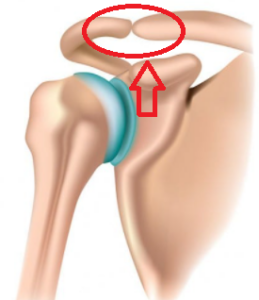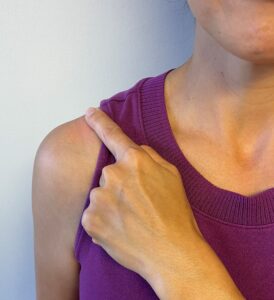Acromioclavicular (AC) Joint Arthritis
What is Acromioclavicular or AC Joint Arthritis?
AC joint or AcromioClavicular joint arthritis is the wearing out of the joint on top of the shoulder. This is the joint where the collar bone and the shoulder blade meet (see picture).
What causes Acromioclavicular or AC Joint Arthritis?
AC joint arthritis usually happens from overuse over time. It can also happen from an injury to the joint years before (AC Joint Separation).
What are the symptoms of AC Joint Arthritis?
If arthritis is present in the AC joint, activities which causes the chest muscles to contract, such as bench press or push-ups, can cause pain in this joint. Also, activities that cause this joint to be compressed such as sleeping on the painful side or pushing down on the joint can cause pain.
How to find out if you have AC Joint Arthritis?
Your doctor will do a physical exam and apply pressure to this joint. If the pressure hurts AC Joint Arthritis is most likely the cause. Having X-rays of the joint are important. An MRI is not very useful since most people over 30 have evidence of wear and tear of this joint on MRI. Most of the people with MRI evidence of AC Joint Arthritis do not have symptoms from the AC joint.
When this joint does bother people, the pain is localized to the “bump” on the top of the shoulder. People are usually able to localize the pain quite well and will often point to the joint with one finger: the “one-finger sign” (see picture).
How is AC Joint Arthritis treated?
If the pain from this joint comes and goes, then it is usually best treated with rest, and avoiding activities that hurt. Over the counter anti-inflammatory pills such as Advil or ibuprofen can also provide relief. If these treatments do not help, an occasional injection of cortisone may help.
If the pain continues, the patient may choose to have surgery. This is called an acromioclavicular (AC) resection. In this simple surgery, the person is placed under general anesthesia (asleep) and a 1 inch incision or cut is made directly over the painful bump. Then a 1/2 inch of the end of the collar bone is removed. The surgery takes only about 15 minutes. Recovery is usually quick with some people returning to normal activities within months.
This surgery can also be done arthroscopically through 2 or 3 small holes about the shoulder. The time it takes to return to normal activity is the same as with the 1 inch incision surgery discussed above.

Normal AC joint

AC joint with arthritis
